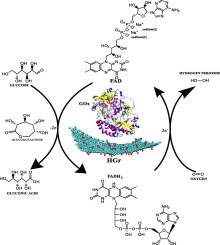当前位置:
X-MOL 学术
›
Diam. Relat. Mater.
›
论文详情
Our official English website, www.x-mol.net, welcomes your
feedback! (Note: you will need to create a separate account there.)
One-step synthesized 2D heteroatom doped graphene for high throughput electrochemical biosensing: A combined experimental and computational studies
Diamond and Related Materials ( IF 4.3 ) Pub Date : 2019-12-01 , DOI: 10.1016/j.diamond.2019.107592 Francis Opoku , Adeniyi Olugbenga Osikoya , Ezekiel Dixon Dikio , Penny Poomani Govender
Diamond and Related Materials ( IF 4.3 ) Pub Date : 2019-12-01 , DOI: 10.1016/j.diamond.2019.107592 Francis Opoku , Adeniyi Olugbenga Osikoya , Ezekiel Dixon Dikio , Penny Poomani Govender

|
Abstract In this study, through the chemical vapor deposition method, we nanofabricated heteroatom graphene (HGr) and dispersed it into poly (3, 4-ethylene dioxythiophene)/poly (styrene sulfonate) to obtain a nanostructured interface material for bioelectronic applications. With X-ray photoelectron spectroscopy, the existence of chlorine, nitrogen, and oxygen as dopants in the lattice of the as-synthesized HGr framework is verified, while structural assessment is performed by Raman spectroscopy. X-ray diffraction spectroscopy disclosed that the synthesized material contained sp2 hybridized carbons. The electrobiocatalytic activity of the conjugate interface material is examined by chronoamperometry using glucose as a sample analyte. The electrobiocatalytic test shows a sensitivity of 381.29 μA mM−1 cm−2, linear response of 1.393 to 8.752 mM and detection limit of 0.05 mM towards glucose sensing. Density Functional Theory (DFT) method is used to study glucose adsorption on Cl-, O-, and N-doped HGr. DFT findings indicated that the existence of Cl as a dopant on the graphene nanosheet greatly favored glucose adsorption on the doped graphene. The adsorption of the glucose molecule is accomplished through the transfer of electrons from the doped graphene to the glucose molecule, which improves the sensing response. The combined computational and experimental studies have shown that the introduced dopants improve the HGr electrobiocatalytic activity.
中文翻译:

用于高通量电化学生物传感的一步合成二维杂原子掺杂石墨烯:结合实验和计算研究
摘要 在本研究中,我们通过化学气相沉积方法,将杂原子石墨烯(HGr)纳米化并将其分散到聚(3, 4-乙烯二氧噻吩)/聚(苯乙烯磺酸盐)中,以获得用于生物电子应用的纳米结构界面材料。使用 X 射线光电子能谱,验证合成的 HGr 框架的晶格中存在作为掺杂剂的氯、氮和氧,同时通过拉曼光谱进行结构评估。X 射线衍射光谱表明合成材料含有 sp2 杂化碳。共轭界面材料的电生物催化活性通过计时电流法使用葡萄糖作为样品分析物进行检查。电生物催化测试显示灵敏度为 381.29 μA mM-1 cm-2,线性响应为 1.393 至 8。752 mM 和 0.05 mM 对葡萄糖传感的检测限。密度泛函理论 (DFT) 方法用于研究 Cl-、O- 和 N 掺杂的 HGr 上的葡萄糖吸附。DFT 结果表明,石墨烯纳米片上 Cl 作为掺杂剂的存在极大地有利于葡萄糖在掺杂石墨烯上的吸附。葡萄糖分子的吸附是通过电子从掺杂的石墨烯转移到葡萄糖分子来实现的,这改善了传感响应。结合计算和实验研究表明,引入的掺杂剂提高了 HGr 电生物催化活性。DFT 结果表明,石墨烯纳米片上 Cl 作为掺杂剂的存在极大地有利于葡萄糖在掺杂石墨烯上的吸附。葡萄糖分子的吸附是通过电子从掺杂的石墨烯转移到葡萄糖分子来实现的,这改善了传感响应。结合计算和实验研究表明,引入的掺杂剂提高了 HGr 电生物催化活性。DFT 结果表明,石墨烯纳米片上 Cl 作为掺杂剂的存在极大地有利于葡萄糖在掺杂石墨烯上的吸附。葡萄糖分子的吸附是通过电子从掺杂的石墨烯转移到葡萄糖分子来实现的,这改善了传感响应。结合计算和实验研究表明,引入的掺杂剂提高了 HGr 电生物催化活性。
更新日期:2019-12-01
中文翻译:

用于高通量电化学生物传感的一步合成二维杂原子掺杂石墨烯:结合实验和计算研究
摘要 在本研究中,我们通过化学气相沉积方法,将杂原子石墨烯(HGr)纳米化并将其分散到聚(3, 4-乙烯二氧噻吩)/聚(苯乙烯磺酸盐)中,以获得用于生物电子应用的纳米结构界面材料。使用 X 射线光电子能谱,验证合成的 HGr 框架的晶格中存在作为掺杂剂的氯、氮和氧,同时通过拉曼光谱进行结构评估。X 射线衍射光谱表明合成材料含有 sp2 杂化碳。共轭界面材料的电生物催化活性通过计时电流法使用葡萄糖作为样品分析物进行检查。电生物催化测试显示灵敏度为 381.29 μA mM-1 cm-2,线性响应为 1.393 至 8。752 mM 和 0.05 mM 对葡萄糖传感的检测限。密度泛函理论 (DFT) 方法用于研究 Cl-、O- 和 N 掺杂的 HGr 上的葡萄糖吸附。DFT 结果表明,石墨烯纳米片上 Cl 作为掺杂剂的存在极大地有利于葡萄糖在掺杂石墨烯上的吸附。葡萄糖分子的吸附是通过电子从掺杂的石墨烯转移到葡萄糖分子来实现的,这改善了传感响应。结合计算和实验研究表明,引入的掺杂剂提高了 HGr 电生物催化活性。DFT 结果表明,石墨烯纳米片上 Cl 作为掺杂剂的存在极大地有利于葡萄糖在掺杂石墨烯上的吸附。葡萄糖分子的吸附是通过电子从掺杂的石墨烯转移到葡萄糖分子来实现的,这改善了传感响应。结合计算和实验研究表明,引入的掺杂剂提高了 HGr 电生物催化活性。DFT 结果表明,石墨烯纳米片上 Cl 作为掺杂剂的存在极大地有利于葡萄糖在掺杂石墨烯上的吸附。葡萄糖分子的吸附是通过电子从掺杂的石墨烯转移到葡萄糖分子来实现的,这改善了传感响应。结合计算和实验研究表明,引入的掺杂剂提高了 HGr 电生物催化活性。





















































 京公网安备 11010802027423号
京公网安备 11010802027423号